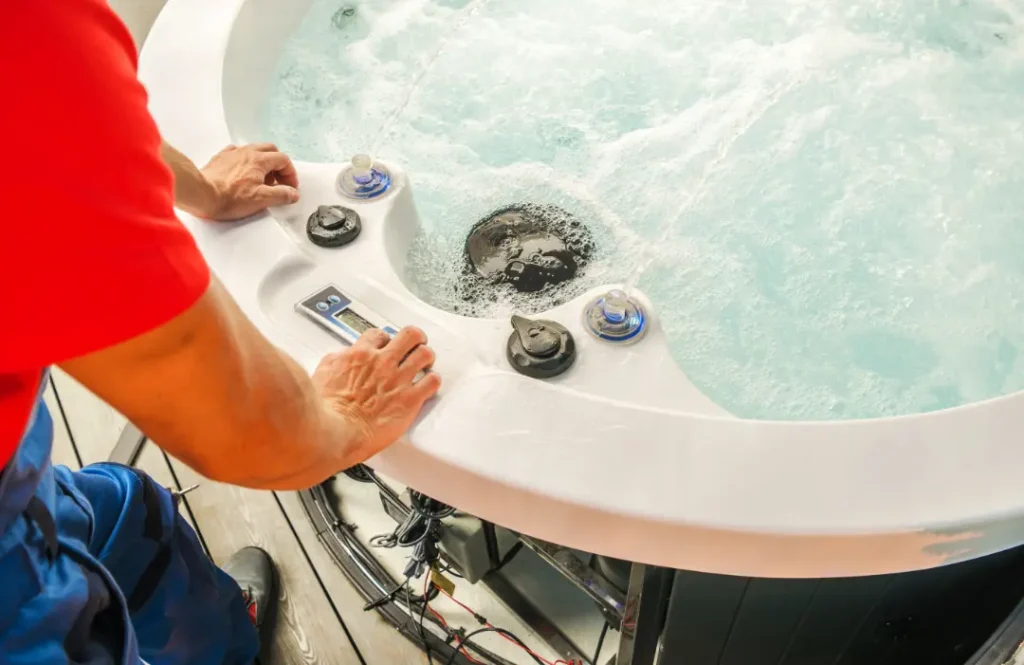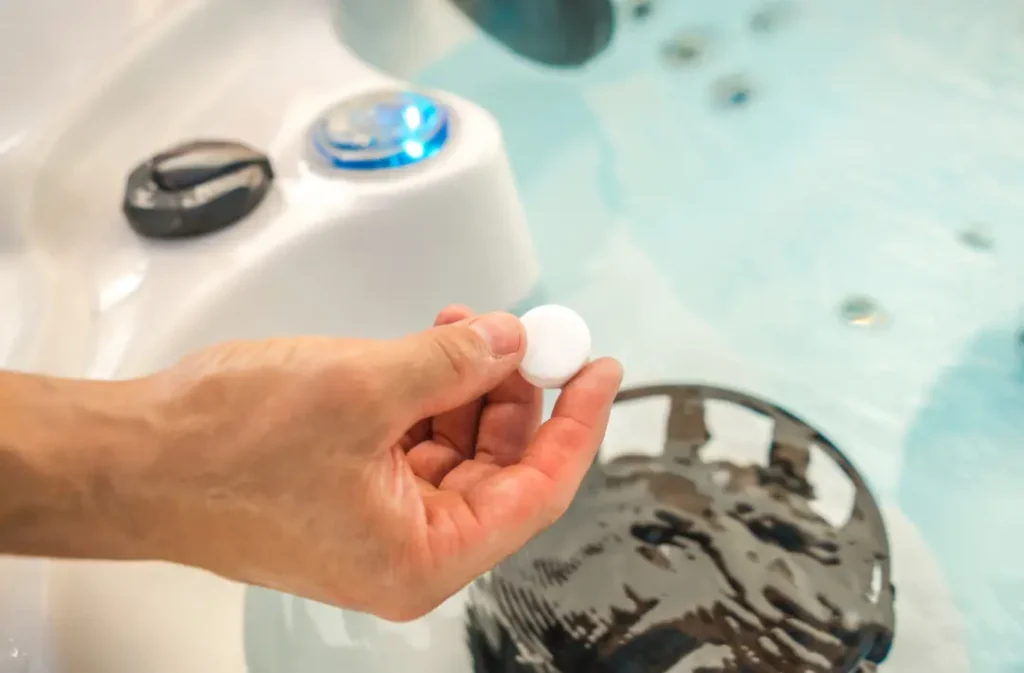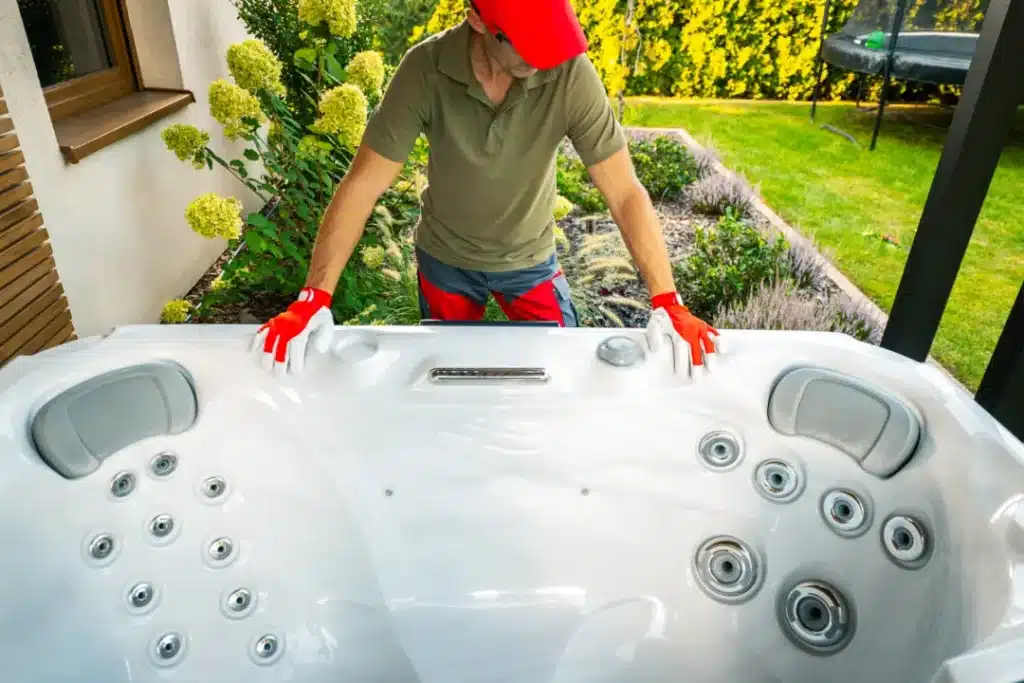Avoid costly repairs and health risks by learning the top things you should never do to your hot tub.
Key Takeaways
- Neglecting regular maintenance and chemical checks can lead to costly repairs and health risks in hot tubs.
- Maintaining proper water levels and avoiding incorrect chemicals is crucial for hot tub performance and user safety.
- Using glassware, prolonged soak times, and DIY electrical repairs pose significant risks; safer alternatives and professional help are recommended.
Neglect Regular Maintenance
Overlooking the routine upkeep of hot tubs can result in expensive fixes and subpar water quality. Generally, crucial tasks for maintaining a hot tub include examining the water, incorporating chemicals, ensuring water circulation, purifying filters, and refreshing the water on a quarterly basis.
Ignoring these maintenance responsibilities could cause considerable harm to your hot tub and present health hazards by breaching vital hot tub safety standards.

Ignoring Filter Cleaning
Hot tub filters are crucial for keeping the water clean and clear. Rinsing these filters with a hose every 2-3 months maintains their efficiency and prevents clogging from debris.
Over time, filters can become clogged with debris, reducing their effectiveness and leading to poor water quality and potential damage to the hot tub.
Skipping Chemical Checks
Skipping chemical checks compromises water safety. Regularly testing your hot tub water for sanitizer, pH, and total alkalinity levels ensures clean and safe water.
Using test strips before and after each soak helps maintain the proper chemical balance, ensuring all chemicals are dissolved and safe levels are reached.
Not Checking Ozonator Functionality
Ensuring the ozonator in your hot tub is functioning correctly is crucial for keeping the water clean and sanitized.
If it fails to operate as expected, there could be a threat to health due to inadequately sanitized water conditions.
Overfilling or Underfilling Your Hot Tub
Maintaining the proper water level is essential for ensuring optimal functioning and extending the lifespan of your hot tub.
Filling it too much or not enough can cause leaks, put extra stress on the pump system, and significantly harm the pump and heating components.
Risks of Overfilling
Filling your hot tub too much can lead to leaks and put extra strain on the pump system, compromising its performance.
If water spills over the sides of the tub, it has the potential to harm both the area around the hot tub and its inner workings.
Dangers of Underfilling
Keeping the water level appropriate is crucial to keeping your hot tub in excellent condition. If the water is too low, the pump can be damaged and malfunction due to insufficient flow and circulation of water. Properly managing the water level helps prevent these problems and keeps your tub functioning well.
Using Incorrect Chemicals
Using the wrong chemicals can disrupt the water balance and potentially harm bathers. Only chemicals specifically designed for hot tubs should be used to ensure proper water quality and avoid system damage.

Avoid Pool Chemicals
Chemicals intended for pool use can upset the equilibrium for maintaining safe water in hot tubs, leading to imbalanced pH levels and harm to the hot tub’s components.
Employing chemicals formulated explicitly for use in hot tubs is crucial to preventing potential harm and ensuring water safety.
Proper Chemical Usage
Maintaining the water quality in your hot tub is essential, and this includes keeping the pH balance at appropriate levels. Bromine and chlorine are frequently used as sanitizers to achieve this, with bromine offering a softer option for those with delicate skin.
To guarantee that your tub’s environment remains clean and safe, it’s important to utilize suitable sanitizers and consistently manage the correct pH levels.
Leaving Your Hot Tub Uncovered
Neglecting to cover your hot tub can result in debris intrusion and escalate energy expenses. It’s crucial to ensure the tub is covered, as this aids in maintaining warmth, diminishing energy use, and preventing debris from entering.

Importance of a Hot Tub Cover
A properly fitted hot tub cover helps decrease energy expenses by retaining heat and shortening the heating system’s run time.
It also keeps leaves, dirt, and various other particles from polluting the water, thus improving the entire experience of using a hot tub.
Heavy Covers
Keeping your hot tub cover free of snow, ice, and debris during winter is essential for its longevity and effective function. Regularly clearing the cover makes handling it easier and safer, reducing the risk of tearing.
Turning Off Power While Full
Shutting down the power to your hot tub while it is still filled with water can lead to internal damage and encourage bacterial proliferation.
Maintaining power to the hot tub helps avert freezing issues and guarantees that water movement persists.
Continuous Circulation
Consistent water circulation helps maintain an even water temperature, protects against freezing, and promotes efficient sanitization. The regular movement of water avoids the creation of stagnant conditions that could result in contamination and harm.
Pump Timer Usage
A pump timer facilitates consistent water circulation within the hot tub by triggering automatic flows at predetermined intervals. This ensures that the hygiene and hot tub temperature levels are maintained effectively even when the tub is not actively in use.
Using Pressure Washers for Cleaning
Pressure washers can damage a hot tub, damaging its outside and inside parts, which could result in leaks.
It’s important to look into milder cleaning approaches and appropriate ways to safeguard the filters of your tub.
Gentle Cleaning Methods
Utilizing a garden hose ensures a soft stream of water that is safe for the hot tub’s surfaces. Employing suitable spa cleaning products helps keep the spa clean and extends its durability.
Protecting Filters
Clean hot tub filters with a dedicated filter cleaner instead of a pressure washer. Regularly using a filter cleaning solution helps maintain the filter’s efficiency and lifespan, improving overall hot tub cleaning performance.
Allowing Water to Become Dirty
Consistently checking the chemical balance of your hot tub’s water is crucial to keep it at the proper levels and secure for use. If you notice that the water has become cloudy or discolored, this indicates a problem that requires swift attention.
It is key to recognize signs of impurities in the water and understand why it’s essential to deal with these problems immediately.
Signs of Contamination
If the water in the hot tub looks cloudy or has a strong odor, it usually indicates that it is contaminated. Do not use the tub if you notice murky or foul-smelling water until the problem has been addressed.
It’s crucial to keep the water clean to ensure safety and a pleasant, relaxing experience when using the hot tub.
Addressing Issues Promptly
Responding promptly upon finding contaminated spa water is critical to preventing health hazards and additional harm. Frequent water testing facilitates the early identification of contamination, which is key to maintaining a safe and delightful hot tub experience.
Using Glassware in the Hot Tub
If glass containers break, using them near the hot tub can lead to serious injuries. Broken glass in the water creates hazardous conditions, complicating cleaning and posing significant risks to users.
Safe Alternatives
Shatterproof materials like plastic or metal are recommended for drinks in a hot tub to enhance safety. Many acrylic drink containers mimic glass but are shatterproof and safe for hot tub use.
Floating acrylic wine glasses and Tritan plastic tumblers are durable, BPA-free, and suitable for hot tub use.
Prolonged Soak Times
Extended periods of soaking in hot water can result in the body overheating and losing too much fluid. It is Safe for adults to soak for around 20 minutes, especially when the water temperature ranges between 101-104°F (38-40°C), which matches typical body temperatures.
Recommended Soak Duration
The recommended maximum soak time is 15-30 minutes. Limiting soak time helps prevent overheating and dehydration.
Consult with your doctor before using a hot tub, especially if you have any health concerns.
Alcohol Consumption
It is recommended to avoid mixing alcohol with the use of hot tubs, as doing so can elevate the risk of dehydration and fainting. The combination can also impair judgment, heightening the likelihood of accidents while in a hot tub.
DIY Electrical Repairs
Embarking on do-it-yourself electrical repairs for your hot tub can pose serious risks. Engaging a professional when dealing with any electrical problems is crucial to guarantee both safety and adherence to regulatory standards.
These are the significance of seeking assistance from a spa professional.
Professional Assistance
Consulting a qualified professional for electrical repairs guarantees both adherence to safety norms and regulatory compliance. Employing a certified electrician to address electrical problems related to hot tubs secures conformity with legal requirements.
Boasting more than 30 years of expertise, Action Spa Repair delivers reassurance in spa and hot tub servicing, building trust among its clientele.
Action Spa Repair Services
Specializing in the diagnosis and repair of multiple brands of hot tubs, Action Spa Repair is dedicated to ensuring that these spas run safely and effectively. We bring over thirty years of industry knowledge to the table, offering extensive repair services designed to keep your hot tub working like new.
We provide prompt services with quick response times and service vehicles stocked with essential supplies, ensuring that customers experience minimal disruption or delay in enjoying their hot tubs.
Frequently Asked Questions
How often should I clean my hot tub filters?
To maintain peak functionality and avoid blockages, it’s essential to clean your hot tub filters once every two to three months. Consider replacing the filters every two years for the best results.
What chemicals should I use for my hot tub?
Use chlorine or bromine levels specifically designed for hot tubs to maintain water quality and protect your system.
How long is it safe to soak in a hot tub?
It’s generally safe to soak in a hot tub for about 20 minutes at a temperature of 101-104°F (38-40°C).
Prolonged exposure can lead to overheating or dehydration.
Can I use a pressure washer to clean my hot tub?
It is discouraged to use a pressure washer to clean your hot tub because it may harm the surface and its internal parts.
To ensure a safe and thorough cleaning, use a garden hose and an appropriate spa cleaner.
Why should I hire a professional for hot tub electrical repairs?
Enlisting the services of a professional for electrical repairs to your hot tub is essential in guaranteeing safety and adhering to regulatory standards. The proficiency of such experts reduces danger and certifies that fixes are conducted accurately, thus averting possible risks.
Conclusion
Maintaining your hot tub properly is essential to avoid costly repairs and ensure a safe, relaxing experience. From regular hot tub maintenance to avoiding incorrect chemicals and ensuring proper water levels, each tip plays a crucial role.
Remember, always seek professional help to keep your hot tub in top condition when in doubt. By following these guidelines, you can enjoy your hot tub worry-free for years to come.
